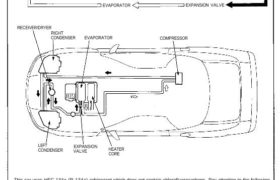Description
Outline
The air conditioning removes the heat from the passenger compartment via the route shown below.
Using the refrigerant (R134a)
Section/compression
High temperature/
high pressure gas
COMPRESSOR I
Radiation of heat
RIGHT/LEFT
CONDENSER
Less moisturized
low pressure vapor
High temperature/ High temperature/
high pressure liquid Traps debris and acts high pressure liquid
as an accumulator.
RECEIVER/DRYER
Absorption of heat
EVAPORATOR
More liquefied
low pressure vapor
EXPANSION VALVE
RECEIVER/DRYER
RIGHT
CONDENSER EVAPORATOR COMPRESSOR
LEFT
CONDENSER
EXPANSION
VALVE HEATERCORE
This car uses HFC-134a (R-134a) refrigerant which does not contain chlorofluorocarbons. Pay attention to the following
service items:
• Do not mix refrigerants CFC-12 (R-12) and HFC-134a (R-134a). They are not compatible.
• Use only the recommended polyalkyleneglycol (PAG) refrigerant oil (ND-OIL 8: P/N 38899-PR7-A01) designed for the
R-134a compressor. Intermixing the recommended (PAG) refrigerant oil with any other refrigerant oil will result in
compressor failure.
• All A/C system parts (compressor, discharge line, suction line, evaporator, condenser, receiver/dryer, expansion valve.
O-rings for joints) have to be proper to refrigerant R-134a. Do not confuse with R-12 parts.
• Use a halogen gas leak detector designed for refrigerant R-134a.
• R-12 and R-134a refrigerant servicing equipment are not interchangeable. Only use a Recovery/Recycling/Charging
System that is U.L.-listed and is certified to meet the requirements of SAE J2210 to service R-134a air conditioning
systems.
• Always recover the refrigerant R-134a with an approved Recover/Recycling/Charging System, before disconnecting
any A/C fitting.
Outline
The air conditioning removes the heat from the passenger compartment via the route shown below.
Using the refrigerant (R134a)
Section/compression
High temperature/
high pressure gas
COMPRESSOR I
Radiation of heat
RIGHT/LEFT
CONDENSER
Less moisturized
low pressure vapor
High temperature/ High temperature/
high pressure liquid Traps debris and acts high pressure liquid
as an accumulator.
RECEIVER/DRYER
Absorption of heat
EVAPORATOR
More liquefied
low pressure vapor
EXPANSION VALVE
RECEIVER/DRYER
RIGHT
CONDENSER EVAPORATOR COMPRESSOR
LEFT
CONDENSER
EXPANSION
VALVE HEATERCORE
This car uses HFC-134a (R-134a) refrigerant which does not contain chlorofluorocarbons. Pay attention to the following
service items:
• Do not mix refrigerants CFC-12 (R-12) and HFC-134a (R-134a). They are not compatible.
• Use only the recommended polyalkyleneglycol (PAG) refrigerant oil (ND-OIL 8: P/N 38899-PR7-A01) designed for the
R-134a compressor. Intermixing the recommended (PAG) refrigerant oil with any other refrigerant oil will result in
compressor failure.
• All A/C system parts (compressor, discharge line, suction line, evaporator, condenser, receiver/dryer, expansion valve.
O-rings for joints) have to be proper to refrigerant R-134a. Do not confuse with R-12 parts.
• Use a halogen gas leak detector designed for refrigerant R-134a.
• R-12 and R-134a refrigerant servicing equipment are not interchangeable. Only use a Recovery/Recycling/Charging
System that is U.L.-listed and is certified to meet the requirements of SAE J2210 to service R-134a air conditioning
systems.
• Always recover the refrigerant R-134a with an approved Recover/Recycling/Charging System, before disconnecting
any A/C fitting.
